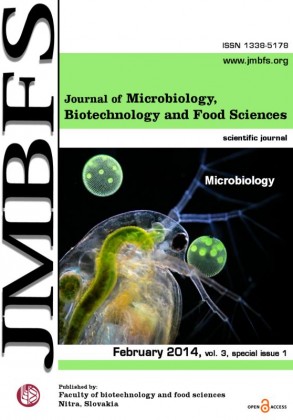ACTIVITY OF SUPEROXIDE DISMUTASE ENZYME IN YEAST SACCHAROMYCES CEREVISIAE
Keywords:
superoxide dismutase, Saccharomyces cerevisiae, oxidative stress, antioxidative enzymesAbstract
Reactive oxygen species (ROS) with reactive nitrogen species (RNS) are known to play dual role in biological systems, they can be harmful or beneficial to living systems. ROS can be important mediators of damage to cell structures, including proteins, lipids and nucleic acids termed as oxidative stress. The antioxidant enzymes protect the organism against the oxidative damage caused by active oxygen forms. The role of superoxide dismutase (SOD) is to accelerate the dismutation of the toxic superoxide radical, produced during oxidative energy processes, to hydrogen peroxide and molecular oxygen. In this study, SOD activity of three yeast strains Saccharomyces cerevisiae was determined. It was found that SOD activity was the highest (23.7 U.mg-1 protein) in strain 612 after 28 hours of cultivation. The lowest SOD activity from all tested strains was found after 56 hours of cultivation of strain Gyöng (0.7 U.mg-1 protein).Downloads
Download data is not yet available.
Downloads
Published
2014-02-01
How to Cite
Lavová, B., & Urminská, D. (2014). ACTIVITY OF SUPEROXIDE DISMUTASE ENZYME IN YEAST SACCHAROMYCES CEREVISIAE. Journal of Microbiology, Biotechnology and Food Sciences, 3(special issue 1 (Microbiology), 250–252. Retrieved from https://office2.jmbfs.org/index.php/JMBFS/article/view/7612
Issue
Section
Microbiology
License
Copyright (c) 2014 Blažena Lavová, Dana Urminská

This work is licensed under a Creative Commons Attribution 4.0 International License.
All papers published in the Journal of Microbiology, Biotechnology and Food Sciences are published under a CC-BY licence (CC-BY 4.0). Published materials can be shared (copy and redistribute the material in any medium or format) and adapted (remix, transform, and build upon the material for any purpose, even commercially) with specifying the author(s).

